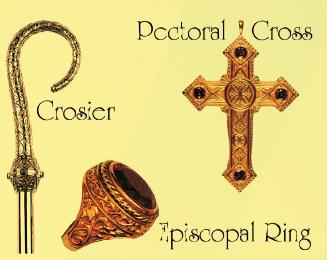The Symbols of the Archbishop
The pectoral cross is a cross, usually about 6 inches in height, worn around the neck of a bishop and suspended by either cord or chain. The pectoral cross is worn on the chest of prelates so as to keep the Cross close to their hearts.
Oct 06, 2014

Pectoral Cross
The pectoral cross is a cross, usually about 6 inches in height, worn around the neck of a bishop and suspended by either cord or chain. The pectoral cross is worn on the chest of prelates so as to keep the Cross close to their hearts.
Crozier
The crozier is the shepherd’s staff used by bishops. The crozier has always been, in the Church, a symbol of the bishop's pastoral role. In the very early Church, it was made of wood, but in the early Middle Ages, metal (silver and gold, depending on rank) was used instead. Wooden croziers again began to be used during the time of Vatican II and are common today. Popes don’t use a crozier, and only since the time of Vatican II have they used a crozier-like staff called the “pastoral staff.” The pastoral staff is silver with a crucifix at the top.
Episcopal Ring
When a Bishop is consecrated, he receives a ring representing his office.
Zucchetto
The zucchetto originated as the Greek pilos and is related to the beret (which itself was originally a large zucchetto). It was adopted circa the Early Middle Ages, if not earlier, to keep clerics' heads warm. Its name derives from its resemblance to half a pumpkin. Its appearance is almost identical to the Jewish kippah (yarmulke), though its significance is quite different. The Pope’s zucchetto is white; the cardinals’ zucchetti are scarlet; the Arch/Bishops’ zucchetti are violet.
Mitre
The mitre imitates the Old Testament priestly head covering and is the headdress of bishops, worn at liturgical functions. It may have a motif or may be plain (simplex). The decorative mitre is worn by celebrants, the simple by concelebrants.
Pallium
The pallium is worn only by archbishops (in their own dioceses), patriarchs, and the Pope, as symbols of their authority. It is a band of white wool adorned with six small black crosses, worn around the neck with extensions front and back, and pinned to the chasuble in three places about the neck. The non-silk part of the pallium is made of white wool, part of which is supplied from two lambs presented annually by the Lateran Canons Regular on the feast of St Agnes (Jan 21). The lambs are solemnly blessed on the high altar of that Church after the pontifical Mass, and then offered to the Pope, who sends palliums made of their wool to the archbishops.







Total Comments:1